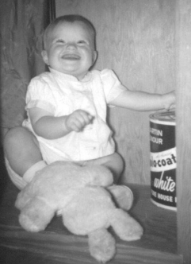I began drawing at a very early age, probably as soon as I could hold a crayon and not want to eat it instead!
before the age of one, with a can of paint already!
I started out drawing animals, insects and imaginary creatures. In my
teens I was drawn to surrealism and began painting imaginary landscapes
in oil and acrylic, often inspired by the literature of C.S. Lewis and Ray
Bradbury. As a teen I actually sold some of these works to private
collectors. My earliest inspiration came from cartoons, then
later from Miro, Kandinsky and Picasso.
I have no formal art education other than life and observation. I did attend, and graduate from the Motion Pictures department of Sheridan College in 1979, and worked in various avant-garde capacities for some 20 years on and off in the Television/Still Photography and Radio Broadcasting fields up until 2000.
For decades I gave up on painting as an expression of my artistic talents and began exploring photography as a freelance dance, theatre, & news photographer. This area also proved difficult to make a living, so eventually I became a certified journeyman and now master painter-finisher so I could pay the bills. But in 2002 I was inspired by my late partner, and also by my deep knowledge of paint technology, to delve into the realm of painting on Plexiglas, and super smooth substrates as my base medium, rather than canvas or paper.
My earliest work had been quite structured and restrained, and feeling that I was breaking free from that, I began to explore work that was expressive yet abstract. I did not want total control in the process. I had a vision of the work being free flowing, reminiscent of satellite or microscopic images, and I saw it as semi translucent. It was then that I hit on the idea of working directly on Plexiglas and press-board to achieve my vision.
My techniques involve what I call "traveling" (pouring) paint into a water "carrier”. Then splashing, splooshing, dragging, using fans & levelers to change flow, or blowing through a straw; all sorts of techniques that mainly do not involve using a brush.
In the 14 plus years that I have been working with these techniques and mediums, my work has evolved. I understand many of the limitations of these processes, but also the liberation, spontaneity, and sheer joy in the surprises these multi-layer techniques produce.
Why not regular glass? I use acrylic glass (Plexiglas) for two reasons. First, polymers (like acrylic) love binding to each other if allowed to dry/cure properly. Plexiglas presents some very odd and contradictory challenges: it's hydrophobic, meaning that it does not bond well with water, yet I use water as the carrier for the acrylic paint. Once the carrier (water) has evaporated, however the medium binds very well with acrylic paint. Second, Plexiglas is much lighter than glass, so easier to handle in framing systems and, as an added benefit, it is one of the few mediums that in and of itself will actually increase in value, as it is made from a non-renewable resource. Plexiglas has a long history as it is one of the oldest plastics to come into mass production, and it does not contain any of the hormone mimicking disruptors that have been great cause for alarm in certain plastics.

